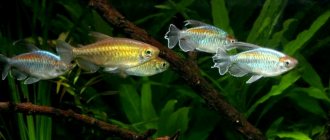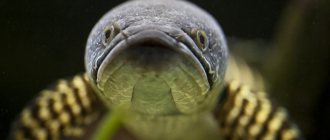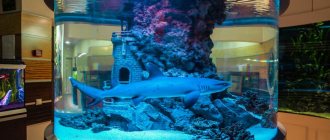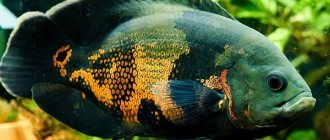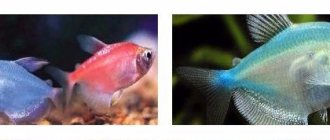Decorative sharks in life and in the aquarium
Exotic predatory fish can inhabit not only coastal sea waters, but also the depths of the oceans. Just imagine: the length of the body of an aquarium shark can be no more than 20 centimeters, and can reach more than 1.5 m. Particularly large specimens are kept by aquarists with extensive experience, in specialized durable aquariums.
An amazing fact is the life expectancy of these fish. There are cases where a shark lived for 20 years in an artificial environment and felt great.
The decorative shark is very similar in appearance to its bloodthirsty relatives. However, these are fish with completely different behavior. She is quite peaceful, calm and does not pose a threat at all. On the contrary, miniature fish are stressed and may become afraid.
Aquarium sharks are not the bloodthirsty predators that are shown in films, but you should still not forget about safety measures.
There are several different domestic toothed predators adapted for life in an aquarium:
- pangasius (shark catfish),
- dwarf,
- feline
- horned.
Sharks require a large tank, preferably more than 400 liters. Do not get carried away by complex decor and intricate lighting of the aquarium. Fish do not need bright light, and complex compositions on the bottom can cause injury. Pay great attention to the issue of aeration and water filtration - your fish need a clean habitat.
Monitor your temperature and diet. The water in the tank should be between 28-30 degrees. The fish's diet should include all kinds of seafood: shrimp, cod fillet, squid, and various shellfish. Both starvation and overeating of fish should not be allowed!
The subtleties of keeping exotic sharks from professionals
Keeping aquarium predators is unproblematic and simple. You should approach the purchase of this fish responsibly and think through the following questions in detail:
- What type of mini sharks to buy for your home.
- What volume of aquarium is suitable for fish to keep them comfortable?
- What decorations, filters and compressors to choose.
Even a novice aquarist can create ideal living conditions by strictly following the order and relying on knowledge.
Aquarium: volume and shape
For proper maintenance, the volume of water for sharks requires at least 400 liters. Otherwise, the fish will not be able to fully move, and therefore develop. Round tanks or hexagon-shaped aquariums are ideal in shape. As decoration, place small pebbles or flat stones on the bottom.
A shark needs a large aquarium in which it can swim in a circle.
Water
Correctly selected water will be a comfortable habitat for sharks. Normally it should be around 28-30 C°. In a cool environment, fish catch colds and become seriously ill. It is preferable to prepare water of medium hardness. A neutral or slightly alkaline environment is ideal for a predator.
Feeding
The shark feeds on seafood. The diet should include shrimp, fresh or frozen squid and lean fish. Young individuals will happily eat ground fish products. For mature predators, it is enough to cut everything into small pieces.
Adviсe
Follow the standards for care and maintenance and you will be able to avoid many problems, and your Pangasianodon hypophthalmus will always be irresistible and attract your attention.
- The shark aquarium must be equipped with everything necessary.
- Don't hand feed.
- Wear gloves when cleaning.
- When adding a new individual to the aquarium, keep it separately for a while to make sure it is healthy.
- It is advisable to keep sick fish separately during the treatment period until complete recovery.
- Purchase a test kit to measure water quality.
- Clean the filter more often.
Remember that the responsibility for the life of this graceful fish, which directly depends on you.
Brief information about decorative aquarium sharks
Among the huge variety of predatory fish, there are obvious giants that can be dangerous to humans if not kept correctly, and there are small exotic specimens, the maintenance of which is adapted to domestic conditions.
False shark (pangasius)
Pangasius or shark catfish, it is also called a false shark. In Southeast Asia, pangasius has been farmed as a commercial fish for hundreds of years; in the wild, it grows up to one and a half meters long. In the aquarium, the maximum recorded size of a false shark is 100 cm, and its age is 20 years.
Shark baloo is a freshwater fish from the barb family that is very similar to sharks, but requires minimal care.
Dwarf shark
Often the body of such a shark reaches a length of only 25 cm. It has quite sharp teeth. The pygmy shark is ideal for an aquarium due to its small size and nature. The fins and belly of the fish glow. The fish lives in the waters of the Indian and Pacific Oceans.
cat shark
The maximum size can reach 1-1.5 meters in length. Needs a huge volume of water: 1000-1500 liters. Sometimes miniature representatives of the family are also found on sale.
Horned shark
It reaches a length of 100-115 cm. Above the eyes there are ridges that resemble horns.
Each shark is endowed with its own character and behavioral characteristics. Decorative aquarium sharks are not only a decoration for your aquarium, but also your favorite pets.
Reproduction
Breeding in captivity is difficult, but you can still try. For spawning, you can take a three-year-old fish: one female (35 cm in size) and several males (25 cm). Possibly in pairs. In the first case, more eggs are fertilized. To breed fish you need a large aquarium - up to two hundred, or better yet four hundred, liters. To obtain offspring, you need to change the temperature and hardness of the water: first lower it, then increase it. The fish are also injected with hormones. Before spawning begins, mating dances can be observed.
The bottom is covered with a separate mesh. The female lays more than 10 thousand eggs. On the third day, young fish emerge from the larvae. The fry's food is ciliates, rotifers, and live dust.
This is a rare breed of fish - a find for true connoisseurs. And may they find a worthy, caring owner in you!
Real shark or Pangasius
Children and adults are very surprised when they learn from a pet store seller that a harmless sea monster is swimming peacefully in an aquarium, and its almost complete copy is a harmless catfish. Pangasius is a beautiful large fish, belongs to the shark catfish family. You can visually identify an aquarium shark from a real predator by its characteristic color and body shape. Young representatives have a bluish or ash color. Bright silvery stripes are clearly visible on the sides of catfishes. Despite the fact that the fish are almost identical, you can recognize a peace-loving catfish by the following characteristics:
- flattened head shape,
- outstanding eye shape and large mouth,
- four mustaches,
- fringe on the anal fin,
- The fin on the back is set upward.
The external differences between pangasius and a real shark are clearly visible in the photo.
The catfish has a certain similarity with a predator in its dynamic swimming style. In a flock they actively scour in search of food and love to swim in circles.
There are 3 types of fish most often found in artificial habitats:
- High-finned pangasius.
- Siamese pangasius.
- Small Pangasius.
An adult shark catfish reaches an average length of 60 cm.
Shark catfish compatibility
Pangasianodon hypophthalmus are completely non-aggressive and are well compatible with other aquarium inhabitants of the same size. In their natural environment they live in large flocks. It is not recommended to keep it with smaller fish, because Pangasius shark considers small fish exclusively as food.
Shark catfish has good compatibility with other fish; the following are suitable for it:
- Cichlids.
- Large and bream-like barbs.
- Kalamoikhty.
- Labeo.
- Proportional polypterus.
- Knife fish.
- Gourami and others.
It should be taken into account that sharks live in the middle column of water, so you should have a neighbor who lives in the lower part.
Secrets of keeping Pangasius from professionals
Pangasius is a demanding and somewhat capricious false shark, so it is not suitable as a first fish for beginners and young aquarists. Those who are a little familiar with exotic fish or are willing to invest money in proper care may want to take a closer look at this species.
Choosing an aquarium
Fish grow quickly and can reach their maximum size in a short time. Therefore, when buying an aquarium, choose the largest capacity and capacity possible.
Pangasius is a schooling fish and it is recommended to have a school of at least 2-3 fish. Otherwise, being alone can lead to severe stress, illness and slow decline!
For a small family of 3 catfish, an aquarium volume of more than 600 liters is desirable. Choose roomy and wide models so that the fish feel comfortable and can move freely through a long space.
Few people know that this type of fish is very prone to jumping. Be sure to take this feature into account before choosing an aquarium model. Choose models with lids or custom ones with durable glass.
Smooth pebbles are suitable for decoration. Pay attention also to pebbles and all types of low-growing plants. Be sure to leave free space in the aquarium for the safety of the catfish. Complex decorative elements can cause injury and bruise.
Aquarium location
Pangasius is very susceptible to stress and fright , so place the aquarium with fish in quiet places where there will be no sudden screams, claps, or other unexpected situations.
When frightened, the catfish loses its bearings and rushes chaotically around space, hitting corners and objects. In addition, a sensitive fish may even faint from fear.
Nutrition
Pangasius feeds not like an ordinary catfish, but while afloat. This large fish will not sink to the bottom to feed, and will definitely not eat up any leftover food. If you notice aggressive and nervous behavior, attacks on neighbors, this means that Pangasius is hungry. Perhaps he simply does not eat enough during feeding. Treat your freshwater friend to special food, fish, chopped squid or shrimp.
00:36
Feeding pangasius
02:43
➤ Harm to pangasius fish ➤
Keeping it clean
By consuming a lot of food and especially meat, fish pollute the water with excretions from waste products. Therefore, it is important to install modern filter and compressor systems in the aquarium. Pangasius will get sick and wither before our eyes from contaminated water. Weekly it is necessary to replace up to 40% of the water in the aquarium with fresh water.
Choice of neighbors
The choice of neighbors for shark catfish must be approached with all responsibility. Suitable for an aquarium with still small sharks:
- barbs,
- angelfish,
- guppy,
- goldfish.
As soon as mini sharks begin to mature and grow, they already regard their miniature neighbors as prey and a tasty lunch. As they grow older, add other large and energetic fish to the catfish. Excellent companions for adult Pangasius will be:
- citron cichlazomas,
- parrots,
- astronotuses,
- other types of Asian fish.
I strongly recommend not keeping pangasius with small and leisurely fish. The small fish will be swallowed or injured by the awkward movements of the large catfish.
Breeding
These fish do not reproduce in a home aquarium.
Shark Ball
Shark Ball
Shark Ball
Order: Cyprinidae (Cyprinidae). Water temperature: 24 - 26°C. “Acidity” Ph : 6.5-7.5. Hardness: 12-16°. Aggressiveness: 10% are non-aggressive. Content difficulty: easy. Compatibility: gets along with virtually all aquarium fish. We can recommend: all tetras - (Congo, thorns, cardinals, lanterns, etc.), viviparous - swordtails, other gouramis, barbs, peaceful cichlids.
Latin name:
Balantiocheilus melanopterus Barbus melanopterus Puntius melanopterus
Russian synonyms:
bala shark, firetail barb,
shark barb, balantiocheilus,
silver shark, tricolor shark.
Foreign titles:
Bala shark, Silver shark, Tricolor shark.
Bala shark is a very interesting silvery fish that looks like a miniature oceanic shark. Of course, they are not relatives, but there are similarities. It is also worth saying that the “Aquarium Shark” is a peaceful and harmless fish. Some people insultingly compare it with a roach, while others do not understand the charm of these fish at all, however, as they say, there are no comrades for the taste and color.
In our opinion, given the unpretentiousness of this fish, given its nimbleness and peculiar shark-like beauty, it can be recommended not only to beginners, but also to experienced aquarists.
Incompatibility: Baloo sharks are not recommended to be kept with slow-moving, veiled fish, such as the goldfish family. And you should also not place them with large, aggressive and territorial cichlids, for example, astronotus. See also the article compatibility of aquarium fish.
How long do they live: By aquarium standards, Baloo’s life is quite long; under good conditions, they live up to 10-12 years. You can find out how long other fish live HERE!
Minimum volume of an aquarium: In principle, a shark can be kept even in an aquarium of 100 liters or more, in such an aquarium you can plant 1, well, a maximum of two fish. However, as you know, the larger the aquarium, the better. Taking into account the fact that these fish are quite large - the fish can reach 35 cm in length, the minimum size of the aquarium for them should be from 300 liters, and preferably 500 liters. If sharks are kept in a small aquarium, they simply will not grow, they will not feel comfortable and, as a result, they will live less.
Find out how many fish you can keep in X liters of aquarium HERE (at the bottom of the article there are links to aquariums of all sizes). The aquarium for Bala sharks should be wide.


